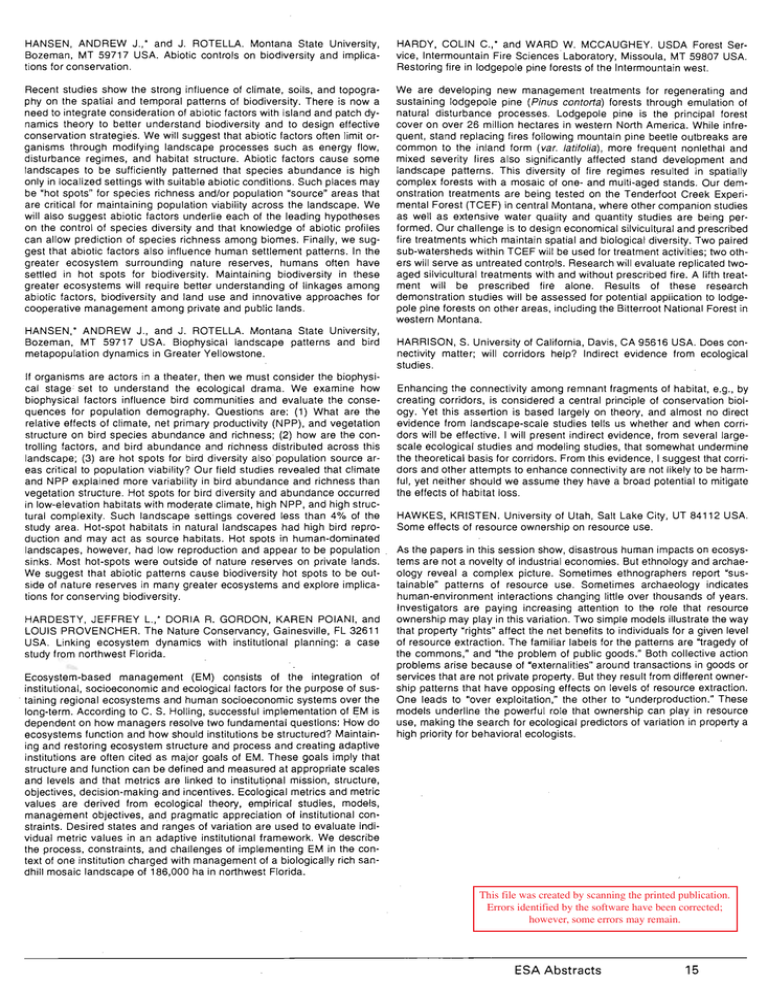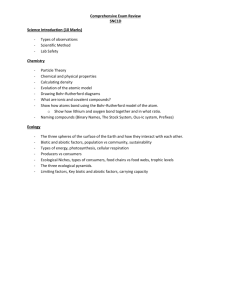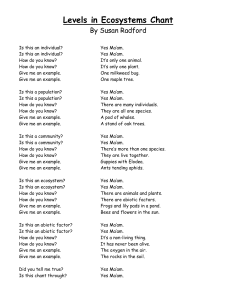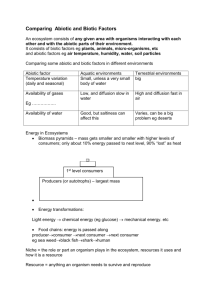HANSEN, ANDREW J.: and J. ... Bozeman, MT 59717
advertisement

HANSEN, ANDREW J.: and J. ROTELLA. Montana State University, Bozeman, MT 59717 USA. Abiotic controls on biodiversity and implications for conservation. HARDY, COLIN C.: and WARD W. MCCAUGHEY. USDA Forest Service, Intermountain Fire Sciences Laboratory, Missoula, MT 59807 USA. Restoring fire in lodgepole pine forests of the Intermountain west. Recent studies show the strong influence of climate, soils, and topography on the spatial and temporal patterns of biodiversity. There is now a need to integrate consideration of abiotic factors with island and patch dynamics theory to better understand biodiversity and to design effective conservation strategies. We will suggest that abiotic factors often limit organisms through modifying landscape processes such as energy flow, disturbance regimes, and habitat structure. Abiotic factors cause some landscapes to be sufficiently patterned that species abundance is high only in localized settings with suitable abiotic conditions. Such places may be "hot spots" for species richness and/or population "source" areas that are critical for maintaining population viability across the landscape. We will also suggest abiotic factors underlie each of the leading hypotheses on the control of species diversity and that knowledge of abiotic profiles can allow prediction of species richness among biomes. Finally, we suggest that abiotic factors also influence human settlement patterns. In the greater ecosystem surrounding nature reserves, humans often have settled in hot spots for biodiversity. Maintaining biodiversity in these greater ecosystems will require better understanding of linkages among abiotic factors, biodiversity and land use and innovative approaches for cooperative management among private and public lands. We are developing new management treatments for regenerating and sustaining lodgepole pine (Pinus contorta) forests through emulation of natural disturbance processes. Lodgepole pine is the principal forest cover on over 26 million hectares in western North America. While infrequent, stand replacing fires following mountain pine beeUe outbreaks are common to the inland form (var. latifolia) , more frequent nonlethal and mixed severity fires also significantly affected stand development and landscape patterns. This diversity of fire regimes resulted in spatially complex forests with a mosaic of one- and multi-aged stands. Our demonstration treatments are being tested on the Tenderfoot Creek Experimental Forest (TCEF) in central Montana, where other companion studies as well as extensive water quality and quantity studies are being performed. Our challenge is to design economical silvicultwal and prescribed fire treatments which maintain spatial and biological diversity. Two paired sub-watersheds within TCEF will be used for treatment activities; two others will serve as untreated contrpls. Research will evaluate replicated twoaged silvicultural treatments wit~ and without prescribed fire. A fifth treatment will be prescribed fire alone. Results of these research demonstration studies will be assessed for potential application to lodgepole pine forests on other areas, including the Bitterroot National Forest in western Montana. HANSEN: ANDREW J., and J. ROTELLA. Montana State University, Bozeman, MT 59717 USA. Biophysical landscape patterns and bird metapopulation dynamics in Greater Yellowstone. If organisms are actors in a theater, then we must consider the biophysical stage set to understand the ecological drama. We examine how biophysical factors influence bird communities and evaluate the consequences for population demography. Questions are: (1) What are the relative effects of climate, net primary productivity (NPP), and vegetation structure on bird species abundance and richness; (2) how are the controlling factors, and bird abundance and richness distributed across this landscape; (3) are hot spots for bird diversity also' population source areas critical to population viability? Our field studies revealed that climate and NPP explained more variability in bird abundance and richness than vegetation structure. Hot spots for bird diversity and abundance occurred in low-elevation habitats with moderate climate, high NPP, and high structural complexity. Such landscape settings covered less than 4% of the study area. Hot-spot habitats in natural landscapes had high bird reproduction and may act as source habitats. Hot spots in human-dominated landscapes, however, had low reproduction and appear to be. population sinks. Most hot-spots were outside of nature reserves on private lands. We suggest that abiotic patterns cause biodiversity hot spots to be outside of nature reserves in many greaier ecosystems and explore implications for conserving biodiversity. HARDESTY, JEFFREY L.: DORIA R. GORDON, KAREN POIANI, and LOUIS PROVENCHER. The Nature Conservancy, Gainesville, FL 32611 USA. Linking ecosystem dynamics with institutional planning: a case study from northwest Florida. Ecosystem-based management (EM) consists of the integration of institutional, socioeconomic and ecological factors for the purpose of sus. taining regional ecosystems and human socioeconomic systems over the long-term. According to C. S. Holling, successful implementation of EM is dependent on how managers resolve two fundamental questions: How do ecosystems function and how should institutions be structured? Maintaining and restoring ecosystem structure and process and creating adaptive institutions are often cited as major goals of EM. These goals imply that structure and function can be defined and measured at appropriate scales and levels and that metrics are linked to institutional mission, structure, objectives, decision-making and incentives. Ecological metrics and metric values are derived from ecological theory, empirical studies, models, management objectives, and pragmatic appreciation of institutional constraints. Desired states and ranges of variation are used to evaluate individual metric values in an adaptive institutional framework. We describe the process, constraints, and challenges of implementing EM in the context of one institution charged with management of a biologically rich sandhill mosaic landscape of 186;000 ha in northwest Florida. HARRISON, S. University of California, Davis, CA 95616 USA. Does connectivity matter; will corridors help? Indirect evidence from ecological studies. EnhanCing the connectivity among remnant fragments of habitat, e.g., by creating corridors, is considered a central principle of conservation biology. Yet this assertion is based largely on theory, and almost no direct evidence from landscape-scale studies tells us whether and when corridors will be effective. I will present indirect evidence, from several largescale ecological studies and modeling studies, that somewhat undermine the theoretical basis for corridors. From this evidence, I suggest that corridors and other attempts to enhance connectivity are not likely to be harmful, yet neither should we assume they have a broad potential to mitigate the effects of habitat loss. HAWKES, KRISTEN. University of Utah, Salt Lake City, UT 84112 USA. Some effects of resource ownerShip on resource use. As the papers in this session show, disastrous human impacts on ecosystems are not a novelty of industrial economies. But ethnology and archaeology reveal a complex picture. Sometimes ethnographers report 'sustainable" patterns of resource use. Sometimes archaeology indicates human-environment interactions changing little over thousands of years. Investigators are paying increasing attention to the role that resource ownership may play in this variation. Two simple models illustrate the way that property "rights" affect the net benefits to individuals for a given level of resource extraction. The familiar labels for the patterns are "tragedy of the commons," and "the problem of public goods." Both collective action problems arise because of "externalities" around transactions in goods or services that are not private property. But they result from different ownership patterns that have opposing effects on levels of resource extraction. One leads to ·over exploitation," the other to "underproduction." These models underline the powerful role that ownership can play in resource use, making the search for ecological predictors of variation in property a high priority for behavioral ecologists. This file was created by scanning the printed publication. Errors identified by the software have been corrected; however, some errors may remain. ESA Abstracts 15





